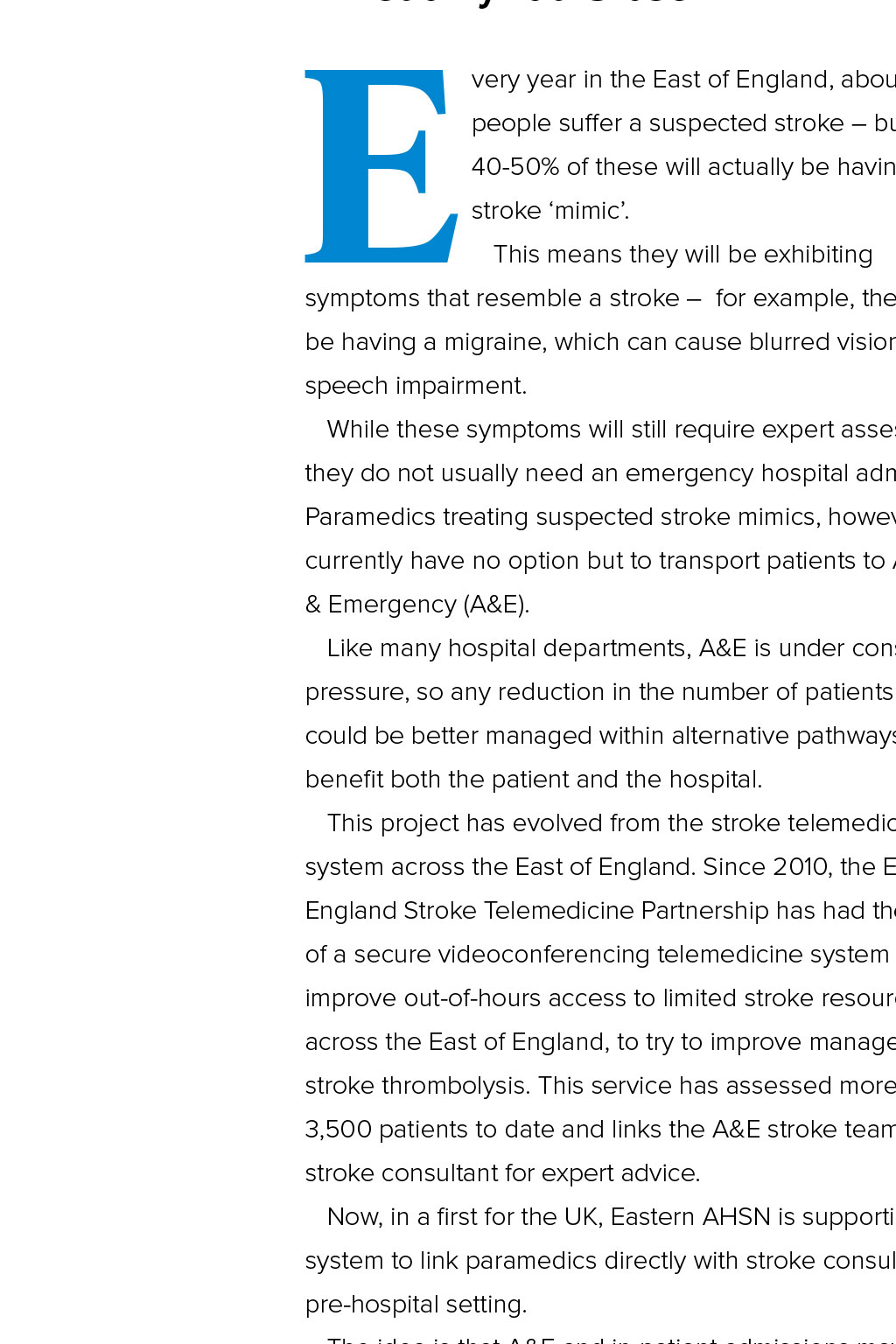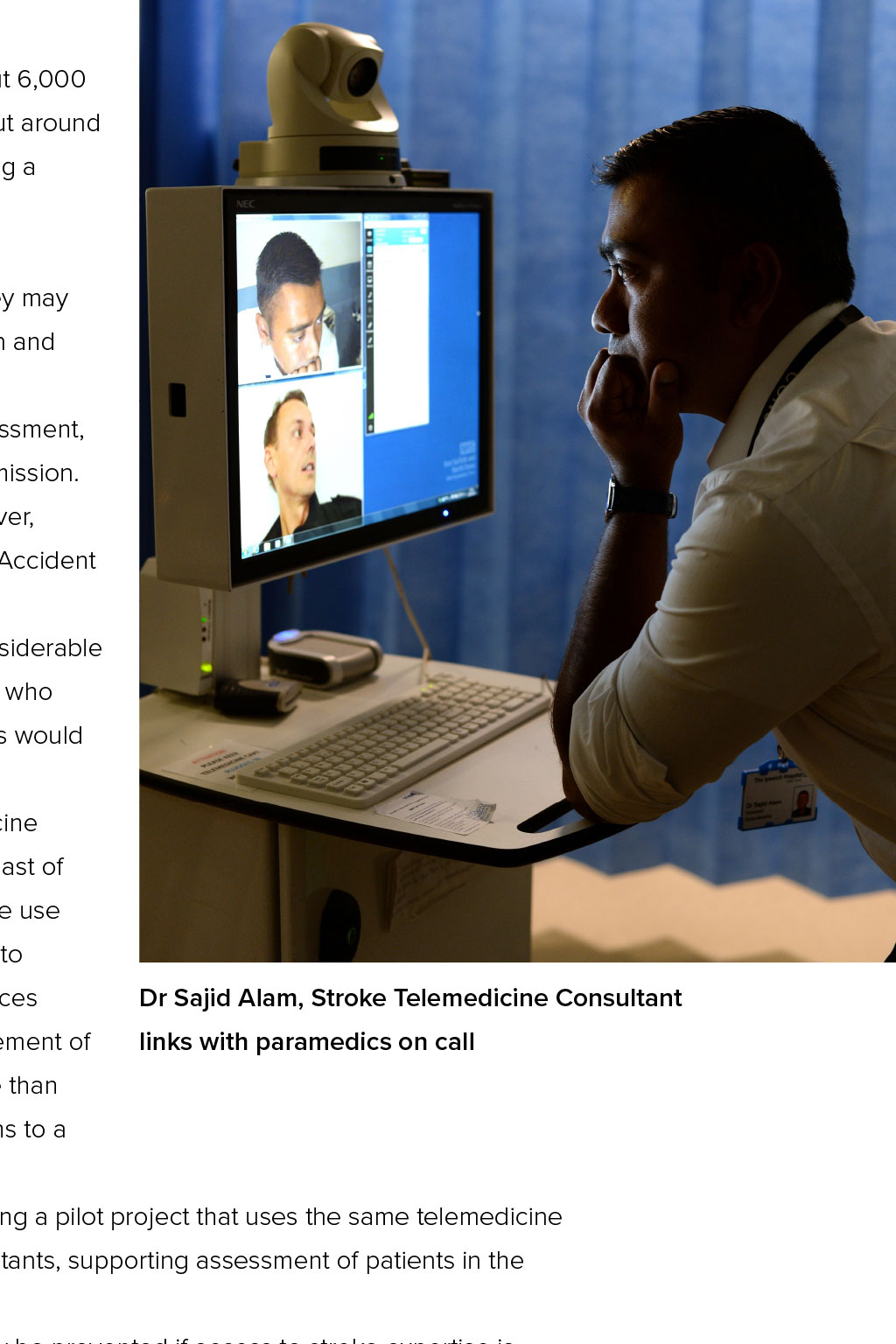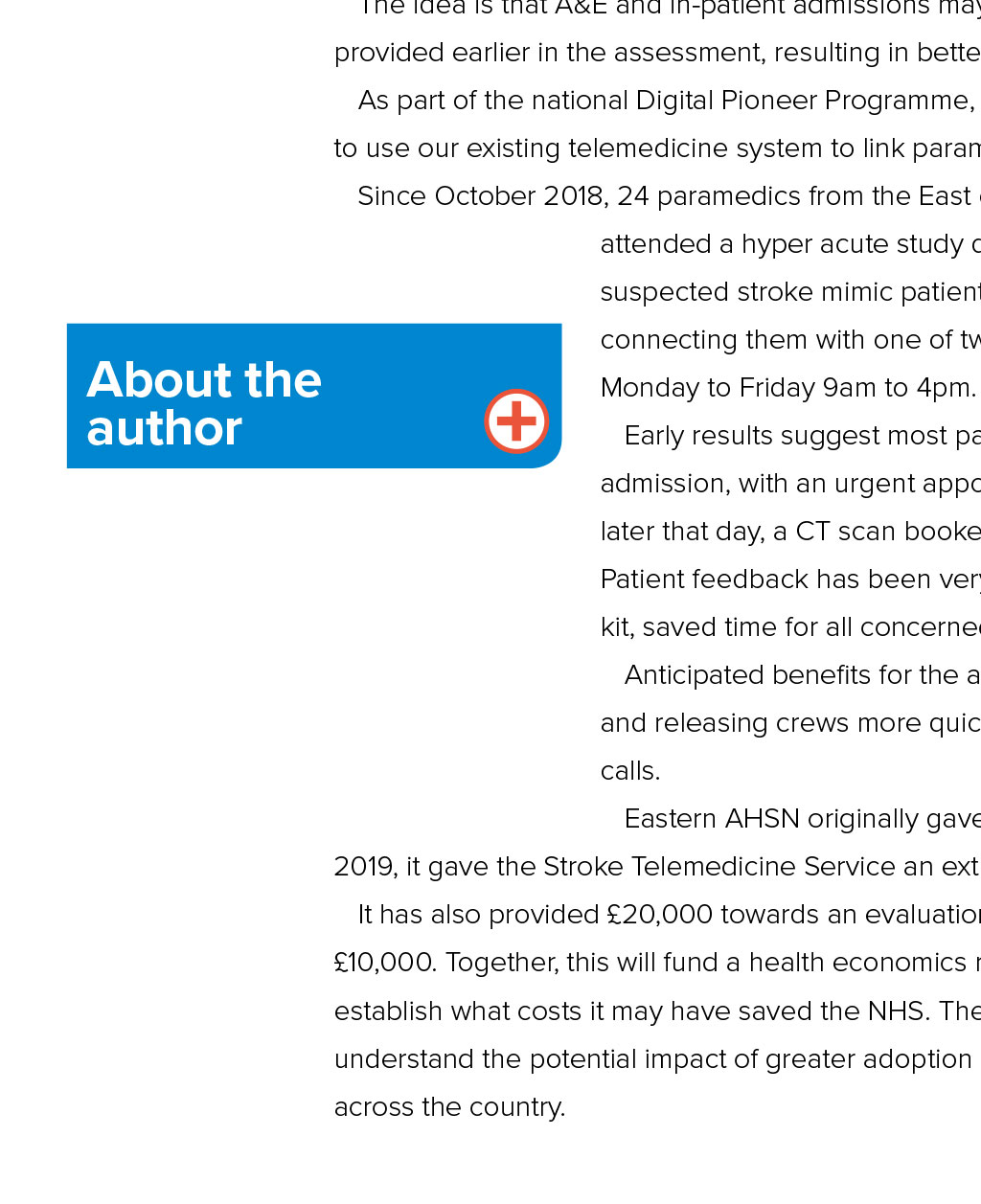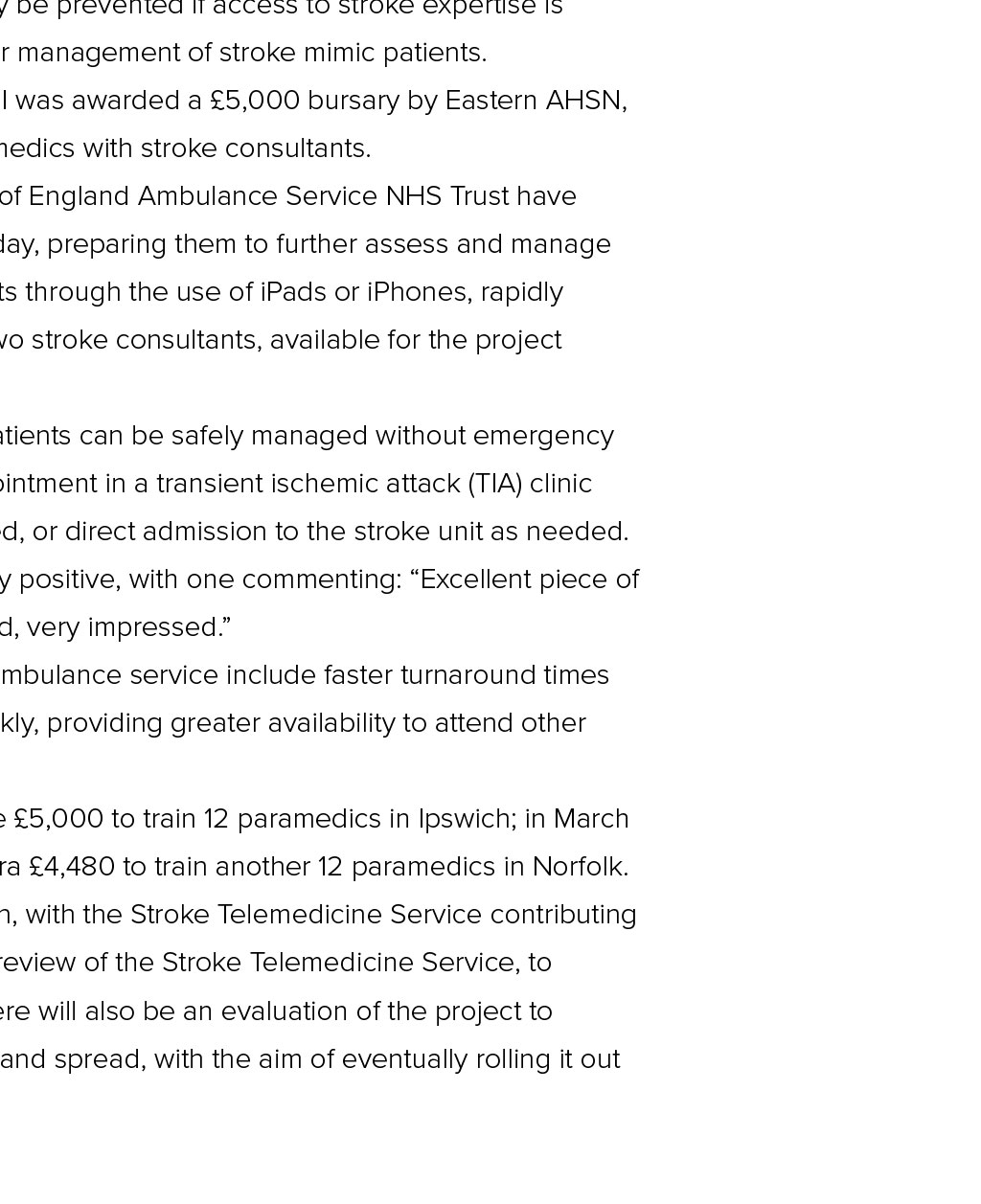












Programme: Stroke Telemedicine Stroke expertise at the touch ofa button A pilot that rapidly links paramedics with stroke consultants is helping to cut the number of emergency admissions, says project Elead Lynda Sibson very year in the East of England, about 6,000 people suffer a suspected stroke – but around 40-50% of these will actually be having a stroke ‘mimic’. This means they will be exhibiting symptoms that resemble a stroke – for example, they may be having a migraine, which can cause blurred vision and speech impairment. While these symptoms will still require expert assessment, they do not usually need an emergency hospital admission. Paramedics treating suspected stroke mimics, however, currently have no option but to transport patients to Accident & Emergency (A&E). Like many hospital departments, A&E is under considerable pressure, so any reduction in the number of patients who could be better managed within alternative pathways would benefit both the patient and the hospital. This project has evolved from the stroke telemedicine system across the East of England. Since 2010, the East of England Stroke Telemedicine Partnership has had the use of a secure videoconferencing telemedicine system to improve out-of-hours access to limited stroke resources across the East of England, to try to improve management of stroke thrombolysis. This service has assessed more than 3,500 patients to date and links the A&E stroke teams to a stroke consultant for expert advice. Dr Sajid Alam, Stroke Telemedicine Consultant at Ipswich Hospital links with paramedics on call About the author Now, in a first for the UK, Eastern AHSN is supporting a pilot project that uses the same telemedicine system to link paramedics directly with stroke consultants, supporting assessment of patients in the pre-hospital setting. The idea is that A&E and in-patient admissions may be prevented if access to stroke expertise is provided earlier in the assessment, resulting in better management of stroke mimic patients. As part of the national Digital Pioneer Programme, I was awarded a £5,000 bursary by Eastern AHSN, to use our existing telemedicine system to link paramedics with stroke consultants. Since October 2018, 24 paramedics from the East of England Ambulance Service NHS Trust have attended a hyper acute study day, preparing them to further assess and manage suspected stroke mimic patients through the use of iPads or iPhones, rapidly connecting them with one of two stroke consultants, available for the project Monday to Friday 9am to 4pm. Early results suggest most patients can be safely managed without emergency admission, with an urgent appointment in a transient ischemic attack (TIA) clinic later that day, a CT scan booked, or direct admission to the stroke unit as needed. Patient feedback has been very positive, with one commenting: “Excellent piece of kit, saved time for all concerned, very impressed.” Anticipated benefits for the ambulance service include faster turnaround times and releasing crews more quickly, providing greater availability to attend other calls. Eastern AHSN originally gave £5,000 to train 12 paramedics in Ipswich; in March 2019, it gave the Stroke Telemedicine Service an extra £4,480 to train another 12 paramedics in Norfolk. It has also provided £20,000 towards an evaluation, with the Stroke Telemedicine Service contributing £10,000. Together, this will fund a health economics review of the Stroke Telemedicine Service, to establish what costs it may have saved the NHS. There will also be an evaluation of the project to understand the potential impact of greater adoption and spread, with the aim of eventually rolling it out across the country. Programme: Stroke Telemedicine A pilot that rapidly links paramedics with stroke consultants is helping to cut the number of emergency admissions, says project Elead Lynda Sibson very year in the East of England, about 6,000 people suffer a suspected stroke – but around 40-50% of these will actually be having a stroke ‘mimic’. This means they will be exhibiting symptoms that resemble a stroke – for example, they may be having a migraine, which can cause blurred vision and speech impairment. While these symptoms will still require expert assessment, they do not usually need an emergency hospital admission. Paramedics treating suspected stroke mimics, however, currently have no option but to transport patients to Accident & Emergency (A&E). Like many hospital departments, A&E is under considerable pressure, so any reduction in the number of patients who could be better managed within alternative pathways would benefit both the patient and the hospital. This project has evolved from the stroke telemedicine system across the East of England. Since 2010, the East of England Stroke Telemedicine Partnership has had the use of a secure videoconferencing telemedicine system to improve out-of-hours access to limited stroke resources across the East of England, to try to improve management of stroke thrombolysis. This service has assessed more than 3,500 patients to date and links the A&E stroke teams to a stroke consultant for expert advice. Dr Sajid Alam, Stroke Telemedicine Consultant links with paramedics on call About the author Now, in a first for the UK, Eastern AHSN is supporting a pilot project that uses the same telemedicine system to link paramedics directly with stroke consultants, supporting assessment of patients in the pre-hospital setting. The idea is that A&E and in-patient admissions may be prevented if access to stroke expertise is provided earlier in the assessment, resulting in better management of stroke mimic patients. As part of the national Digital Pioneer Programme, I was awarded a £5,000 bursary by Eastern AHSN, to use our existing telemedicine system to link paramedics with stroke consultants. Since October 2018, 24 paramedics from the East of England Ambulance Service NHS Trust have attended a hyper acute study day, preparing them to further assess and manage suspected stroke mimic patients through the use of iPads or iPhones, rapidly connecting them with one of two stroke consultants, available for the project Monday to Friday 9am to 4pm. Early results suggest most patients can be safely managed without emergency admission, with an urgent appointment in a transient ischemic attack (TIA) clinic later that day, a CT scan booked, or direct admission to the stroke unit as needed. Patient feedback has been very positive, with one commenting: “Excellent piece of kit, saved time for all concerned, very impressed.” Anticipated benefits for the ambulance service include faster turnaround times and releasing crews more quickly, providing greater availability to attend other calls. Eastern AHSN originally gave £5,000 to train 12 paramedics in Ipswich; in March 2019, it gave the Stroke Telemedicine Service an extra £4,480 to train another 12 paramedics in Norfolk. It has also provided £20,000 towards an evaluation, with the Stroke Telemedicine Service contributing £10,000. Together, this will fund a health economics review of the Stroke Telemedicine Service, to establish what costs it may have saved the NHS. There will also be an evaluation of the project to understand the potential impact of greater adoption and spread, with the aim of eventually rolling it out across the country. Stroke expertise at the touch ofa button About the author Lynda Sibson, Telemedicine Manager, Stroke Telemedicine Stakeholder Partnership, and project lead